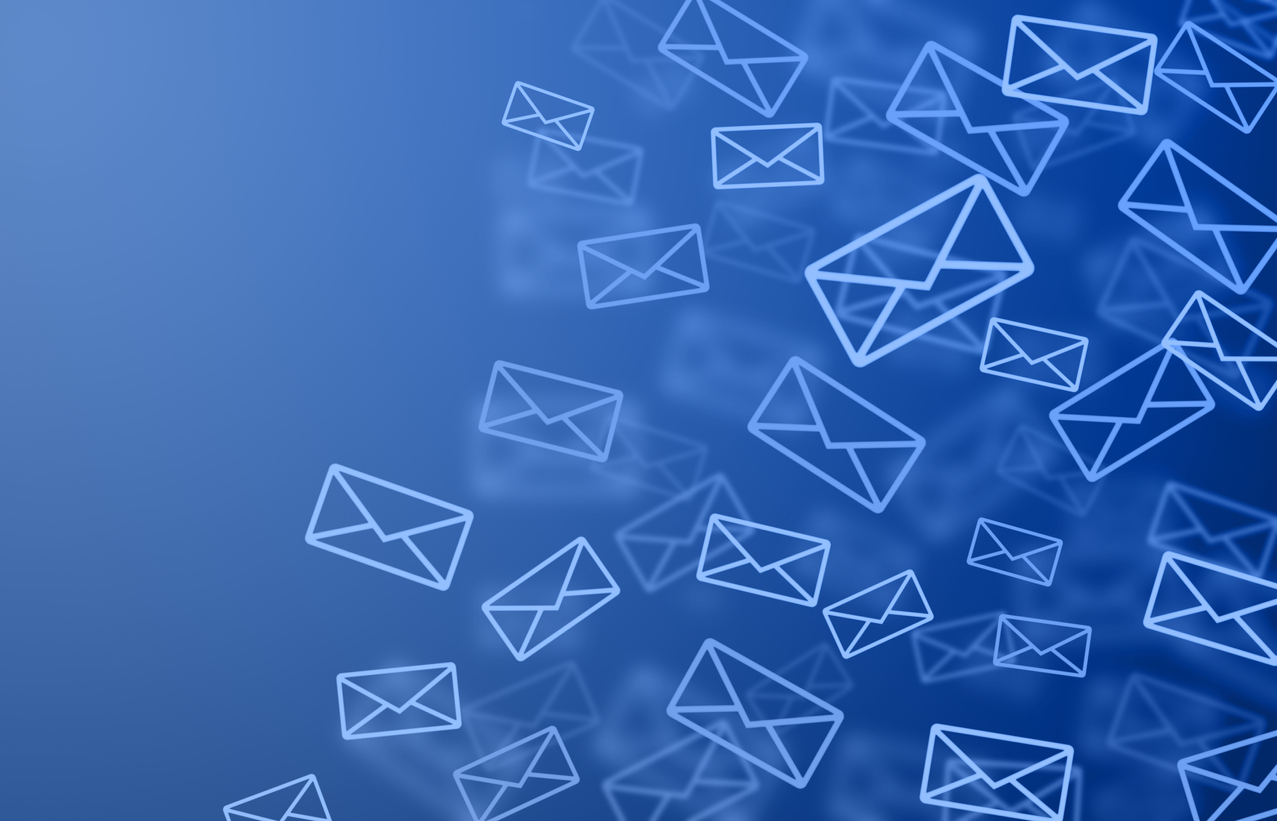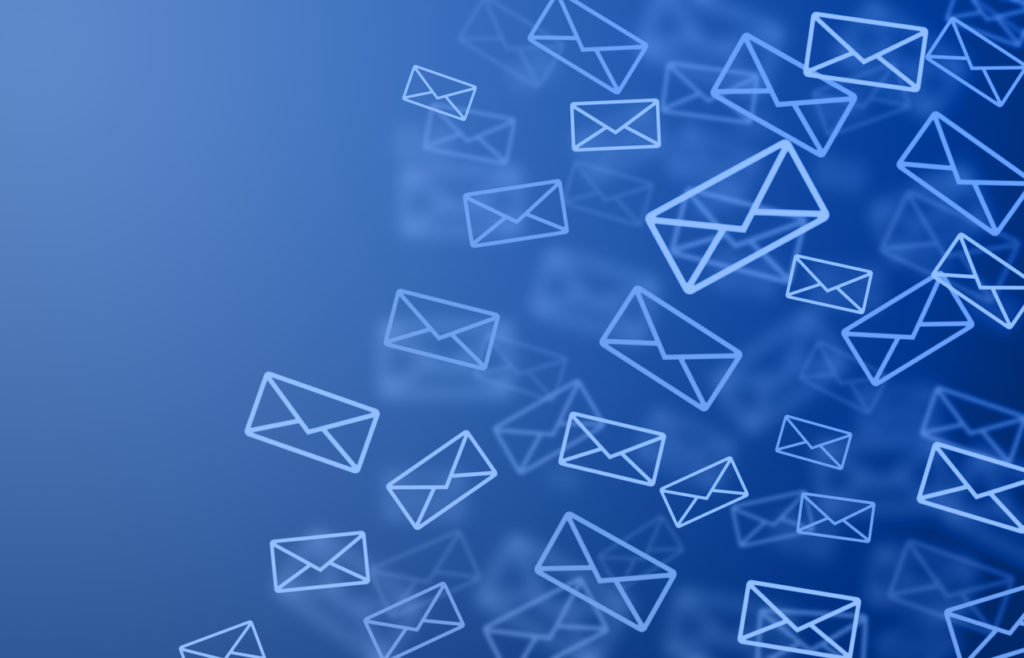
Email Marketing
No matter the goal of an email marketing campaign, it’s important to follow best practices when communicating with prospects and customers.
The importance of email marketing
Whether the goal of your campaign is to generate leads, boost brand loyalty or increase brand awareness, email remains an essential channel for reaching out to prospects and turning browsers into buyers.
Email marketing can be used to drive the sales funnel among customers who’ve shown interest in your brand, such as those who’ve signed up for a newsletter or registered for gated content like ebooks. It can also be an essential channel for engaging existing users and driving upsells.


- The importance of email marketing
- How to build a strategy following email marketing best practices
- How to write email marketing copy that drives results
- Email marketing best practices for list building
- Email marketing examples to inspire your next campaign
- Why choosing the best email marketing service is important
- Top email marketing tools every marketer should know
- Ready to take your email marketing strategy to the next level?

How to build a strategy following email marketing best practices
When done well, email is one of the most effective marketing tools for reaching your audience. Although it won’t guarantee the success of your business alone, when integrated with other digital marketing efforts, email marketing can yield numerous benefits.
However, a poorly designed strategy can have dire consequences for your audience’s perception of your brand and your business in general. But don’t worry, we’re here to guide you on how to build successful campaigns following email marketing best practices.
Email is used by people all over the world for many different purposes, including staying in touch with friends and family, requesting information, applying for jobs, and – in the marketing world – connecting with customers. The way emails are composed depends on the audience they are intended for, so they can differ in their formality, content and desired outcomes.
In a business context, marketers may send emails for a variety of purposes. Sending emails can be used as a tool to build relationships with prospects and customers, promote content, generate new leads or to boost brand awareness. But with many more modern tools available, why does email remain one of the most popular marketing channels today?
There are more than 4 billion email users worldwide. In 2022, an average of 333.2 billion emails were sent each day. How often do you check your emails? We’re guessing at least once or twice a day. For some people, it’s the first thing they do when they wake up in the morning and many get push notifications straight to their smartphones when a new email comes through.
If a potential customer has subscribed to your email list, it means they are interested in what you have to say and will appreciate being updated with the latest products and promotions. Email is one of the most personal forms of digital communication, which allows businesses to have “one-to-one” conversations with their customers as opposed to advertisements or social media posts aimed at the masses.
Despite its ubiquitous nature and accessibility, if you’re looking for other reasons to engage in email marketing you just need to look at the statistics.
According to Omnisend, for every $1 (£0.84) you spend on email marketing, you can expect an average return of $40 (£34), which means it offers one of the highest returns compared to any other form of digital marketing.
A Hubspot survey of over 300 US email marketers found that the days their marketing emails got the most engagement were Monday (22.6 per cent), Tuesday (24.9 per cent) and Wednesday (21.3 per cent). However, Optinmonster posits that Tuesdays and Thursdays are the best days to send business emails. From this information, we can glean that weekdays are the best for scheduling emails to be sent out, but not Fridays as people may already be winding down for the weekend.
Although there’s no general consensus on the best day of the week to send out an email newsletter and other collateral, there are key hours during the day that have more successful results.
The same Hubspot research reported the highest engagement for emails was those sent between 9am to 12pm (34.9 per cent) and 12pm to 3pm (27.6 per cent). Key transition times can be identified, for example 8am is a great way to reach people first thing in the morning and 6pm is a prime hour of the day to capture people’s attention on their evening commute. But this doesn’t mean you need to be up at 8am to write, check and send an email at 9am. Email marketing software solutions allow you to schedule optimal times for sending emails.
You probably don’t think twice about formatting and timing when reaching out to friends via email, but using it as a tool for marketing requires more careful consideration.
The goal of email marketing is to generate leads and deliver value to the lives of your subscribers, for that reason crafting the perfect online communication message requires careful attention to detail. Everything from the subject line to the time of day can affect email deliverability and open rate, so it’s important to follow some best practices when crafting your campaigns.
- Subject line: The reader should know what they’re getting without having to click open. Clear, actionable and engaging language that’s relevant to the body of the email is key.
- Get the copy right: The body of your email should be concise and consistent with your brand’s tone of voice.
- Include multimedia: Images, videos, animated graphics and interactive content can make a huge difference to how much engagement your emails drive. Remember that media should be relevant and optimised for all devices.
- Timing: The time of day you send our email blasts can affect whether or not your subscribers open them. Follow the guidance provided above to make sure your emails are being read.
- Responsiveness: Over half of emails are opened on mobile devices. Make sure your communications are optimised for this.
- Personalisation: Avoid generic copy and write as though you’re speaking to a friend (without being too informal).
- CTA: Include a call to action (CTA) to let the reader know what they need to do next.

How to write email marketing copy that drives results
The average email open rate is 19.7 per cent. That’s not a bad number, but if you want to ensure your message gets opened and drives results, you’ll need to have an effective strategy in place. It’s not just about ensuring that the prospect sees your offer, great email marketing means breaking down the different elements to boost engagement and increase the recipient’s potential for conversion.

Does your subject line make your prospect want to open the email?
Generic subject lines are one thing that’ll guarantee your emails go unopened. If you want to capture the reader’s attention, make sure you think of a catchy title that garners their interest. Good subject lines are typically personalised, engaging and descriptive. They give the reader a reason to open the email. Here are some best practices to follow to ensure your email marketing subject lines make the prospect click.
Add personalisation
Emails with personalised subject lines have a 50 per cent higher open rate. Good ways to do this include using the recipient’s name in the subject line, sending automated birthday or anniversary emails, and tapping into their transaction history to ensure the offer or information is relevant.
Be descriptive
Be as descriptive as possible in the limited word count you have. Communicate the benefits of your promotions and be sure to call attention to specific details in the subject line. Action words work well as they will let the reader know what you want them to do, while also creating a sense of urgency.
Be concise
Shorter subject lines are often more effective than longer ones, particularly considering that 46 per cent of email opens happen on mobile devices. You want to capture the recipient’s attention as quickly as possible and make sure the words you choose show the value you have to offer. We recommend keeping subject lines to no more than nine words.



Are you delivering what you promised when your customers subscribed?
If your customers handed over their information when they subscribed to your email list, it’s important to respect that by delivering on what was promised. Making sure email marketing content is relevant to their interest and pain points is essential if you want to avoid potential customers turning into unsubscribers. For instance, if you promised to share a monthly newsletter filled with industry news and company updates, don’t start bombarding them with irrelevant offers and promotions.
How can you hold readers’ attention and provide value to ensure they stay subscribed?
Once the recipient has opened the email, you need to make sure the content inside offers something of value and encourages them to continue reading. The first thing to keep in mind when writing email marketing copy is to know your audience. Understanding who your subscribers are will help you to tailor your message to meet their needs and ensure that the tone is relatable. Here are some tips for making sure your copy holds the reader’s attention.
- Personalisation: This is one of the most important elements of email marketing copywriting. Although you may be sending messages to hundreds or thousands of recipients, be sure to write as though you are speaking directly to the reader and address them by name and using second-person pronouns.
- Nail down the right tone: Email, unlike social media, is private and personal, which is why it’s a good idea to keep the tone conversational and approach readers as individuals.
- Avoid industry jargon: Don’t try to establish your authority by using a bunch of complicated words that no one apart from those in your industry will understand. Likely, people have subscribed to you to learn more about a topic that interests them, so don’t alienate them before they get the chance to become familiar with the subject.
- Keep it relevant: No one wants to receive emails about things they couldn’t care less about. One of the top reasons people unsubscribe from emails is that they feel the content is not relevant to them. Sending general emails to your entire contact list isn’t effective. Instead, create audience segments based on subscribers’ interests, transaction history, demographics and other factors to help you share content that’s relevant and valuable. We talk more about how to do this next.
- The importance of email marketing
- How to build a strategy following email marketing best practices
- How to write email marketing copy that drives results
- Email marketing best practices for list building
- Email marketing examples to inspire your next campaign
- Why choosing the best email marketing service is important
- Top email marketing tools every marketer should know
- Ready to take your email marketing strategy to the next level?
Email marketing best practices for list building
Before you can succeed with email, you need to build up a base of people to send them to. An email list refers to a group of users who have given their permission for you to send them relevant communications. To build these lists, you need them to opt in to receive emails.
Email lists can take a while to build and when you start you may have just a few contacts to reach out to. In time and with effective email marketing practices, you’ll start to see your list grow organically.

How do you create an email list?
There are various ways to build your email list, but it really comes down to two things that combine to grow your subscribers: lead magnets and opt-in forms.
Use lead magnets
Lead magnets attract prospects to your email list by offering them something in return for their information. Note that consumers have become increasingly protective of their personal data, which means you need to make sure that what you’re offering is valuable.
You can repurpose existing content to create lead magnets, or set aside some budget to create one from scratch.

Lead magnets should be relevant and useful and make some kind of difference in your prospects’ lives. Examples of lead magnets you can create include:
- Ebooks
- Whitepapers
- Infographics
- Research (reports and studies)
- Checklists
- Templates
- Webinars

Create opt-in forms
An opt-in form is a form of consent that web users give to signal their interest in a product or service or authorise a business to contact them with more information. This form pops up on your website or is embedded in your navigation or footer and collects the user’s email address, name and any other data that they input which is then stored in your marketing platform.
The main reason to add opt-in forms to your website is that sending unsolicited emails can get you in trouble, but there are many advantages to using them beyond compliance. Well-designed and captivating opt-in forms can encourage visitors to your website to subscribe to your email list, which allows you to harness further opportunities to connect with them.
Here are some tips for creating effective opt-in forms that encourage visitors to take the next step:
- Offer them something (such as a lead magnet or a monthly newsletter)
- Keep opt-in forms simple with just a few fields
- Feature a headline and a short description so they know what they’re signing up for
- Use a bright, eye-catching CTA

What other marketing tactics can you use to encourage email sign-ups?
There are many ways to encourage visitors to your website or other pages to sign up to your email content. Here are some other email list building tactics you can try if you’re not seeing the conversion rate you want.
Share unique email content
One best practice to grow your email list for free is to ensure your current subscribers are receiving quality content. If your email communications are always informative, inspirational and relevant, recipients will continue to engage with them and are more likely to forward or recommend your business to their friends for more exposure and subscribers.
Grow your email list with social media
Social media is one of the most powerful tools available to marketers today, with a whopping 93 per cent using it for business. If your brand already has a social presence, why not leverage your existing reach to grow your email list to send more direct and personalised communications to your audience?
Here are some simple ways you can use social media to attract more subscribers:
- Promote your gated content on platforms like Facebook, Instagram and Twitter
- Create a lead-generating Facebook ad
- Offer incentives on your social platforms such as coupons, discounts or freebies in exchange for their email address

Include a newsletter signup option at checkout
Your checkout page can be a powerful marketing tool if you know how to use it. The buyer’s journey doesn’t end once they make a purchase, which is why it’s a good idea to encourage users to sign up for your email list at checkout.
Many people choose to complete their transaction without creating an account, but by simply adding a newsletter sign-up option under the information fields they need to provide to check out, you can retain a connection that encourages them to become repeat customers. Be clear about the value they will receive from signing up, whether it’s exclusive discounts, informative content or other incentives to opt in to your email list.
Email marketing examples to inspire your next campaign
Not sure where to start with email marketing? Take a look at these examples for some inspiration.
- Welcome email: These are a great way to personally say hello to new subscribers and give them a taste of what’s to come. Welcome emails are a chance to highlight your brand’s values, showcase product features and make a great first impression.
- Informational email: Also referred to as promotional emails, these are typically sent to announce sales, offer free trials and share product updates. Make sure informational emails aren’t too salesy, otherwise your readers may send them straight to spam.
- Newsletter: Sending a regular digital newsletter is a great way to nurture your audience and drive engagement. Give them insight into your company and share valuable content to drive traffic to your website and increase your credibility.
- Transactional email: This type of email is triggered based on a specific action taken by a prospect or customer. Examples include confirmation emails, form submission emails and welcome emails. Their purpose is to acknowledge the transaction taken by the customer and encourage further engagement.
What email marketing practices keep your readers engaged?
If you want to keep subscribers engaged with your email campaign beyond your welcome message, there are some things you can do to retain their attention.
Keep a casual tone
Nobody wants to wake up to jargon-heavy, serious emails in their inbox every day. By keeping the content of your electronic mail casual and fun you’ll better engage your readers and ensure they associate your brand with a positive message. Humour is always good, too.
Conduct A/B testing
This involves testing each element of your email campaigns (subject line, preview texts, copy, design, etc) to see how your readers are responding. A/B testing allows you to better understand your target audience and how they interact with your content so you can identify areas for improvement.
Segment your email lists
If you want to truly increase conversions, you’ll need to segment your email lists to reach the right customer with the right message, at the right time. To do this, you can integrate your email marketing tool with your CRM to combine your customer data and personalise emails.
Don’t leave CTAs to the end
People won’t always reach the end of your email. For this reason, it’s a good idea to add CTAs throughout to increase the chances of them clicking through. This isn’t to say you should go overboard, instead give readers a few chances to take action before they reach the end.

Make emails social-friendly
Your email marketing and social media marketing strategies should complement each other. Encourage readers to stay connected by including buttons that link to your social media pages in emails and let subscribers to share email content directly on social media to promote engagement. This way, if they read something they like, they can share it with their followers.
Familiarise yourself with analytics
To optimise your future campaigns, you’ll need to know what works and what doesn’t, you’ll need to get to grips with analytics. By analysing the data in your email marketing platform you can see your email open rate, what readers clicked on, how well they drove traffic back to your website and which offers people engaged with the most.
Optimise for mobile
We’ve already mentioned that the majority of emails received today are opened on mobile. Make sure that your content is fully optimised for mobile devices to prevent readers from becoming frustrated. Most email marketing platforms offer mobile-optimised email template options so all you need to do is add your own content and design.
Use your branding
While we’re on the topic of design, it’s important to ensure your email looks unique to your brand. You don’t have to hire a graphic designer in order to stand out, just ensure you have an elegant design that’s simple, attractive and aligns with your company’s aesthetic across other platforms.
What could you do with these emails to move people through your customer journey?
Welcome emails, newsletters and one-off campaigns play an important role in any email marketing strategy. However, today marketers are leveraging email to set up customer journeys based on predefined triggers.

Email automation tools allow marketers to send personalised messages based on where each recipient is in their customer journey, so they can be targeted with the right content at the right time. For instance, the customer journey begins with the initial email – whether that’s a customer inquiry, a promotional email or something else.
After this, the next email in their customer journey is automatically sent when they reach a trigger established in your email marketing software to keep moving them forward. Triggers may be certain dates, such as holidays, or activities.
- The importance of email marketing
- How to build a strategy following email marketing best practices
- How to write email marketing copy that drives results
- Email marketing best practices for list building
- Email marketing examples to inspire your next campaign
- Why choosing the best email marketing service is important
- Top email marketing tools every marketer should know
- Ready to take your email marketing strategy to the next level?
Why choosing the best email marketing service is important
If you want to ensure you get the most out of your email marketing strategy, consider working with an agency that’s experienced in running successful campaigns for businesses of all sizes.
Email marketing brings many challenges. If you’re unfamiliar with best practices or you simply don’t have the time and resources to tackle it in-house, working with a digital agency that offers email marketing services can take the task off your plate and free up your time to handle other important business operations.
There are countless agencies offering email marketing services, but it’s important to select the right partner with the skills and experience required to execute effective campaigns.

The most significant challenges faced by email marketers include earning new subscribers, increasing email open rates, improving email deliverability, retaining subscribers and achieving measurable ROI. Luckily all of these challenges can be overcome with the right approach from an agency that knows how to develop a robust email marketing strategy.
Working with an agency that offers email marketing services provides you with access to a team of experts who know the ins and outs of developing and executing successful campaigns. Whether you run a small business seeking to grow your email list or a large enterprise that wants to increase engagement, an agency works with you to understand your goals and create a strategy that drives results.
A digital agency that offers email marketing services can work with your business to build and execute an entire campaign. Among the activities they’ll be able to help you with are:
- Grow your email database and nurture subscribers
- Set up automated email workflows
- Write and design unique and personalised content for your target audience
- Measure the results of your campaign and optimise for the future
Axonn is a full-service digital agency that offers email marketing services for businesses across industries. We’re a team of marketers experienced in strategy, content creation and campaign management who know how to develop email marketing campaigns that attract, engage and nurture your audience. Together, we can overcome the challenges of email marketing with effective campaigns that keep your subscribers curious, satisfied and engaged.

Top email marketing tools every marketer should know
Just like a tradesperson needs their own set of tools to effectively do their job, email marketers rely on various software platforms to generate powerful campaigns. There are many email marketing tools available at various price points, but it’s important to assess your options to find the right one to meet the needs of your business and your customers.
Whether you’re looking for a marketing tool that automates workflows or offers a quality template selection, email marketing software can give your campaigns the boost they need to drive results. Here are some of the top email service provider tools that marketers are embracing.
Mailchimp
Possibly the most well-known email marketing tool, Mailchimp is a marketing automation platform and email marketing service that allows you to target leads with audience segmentation, optimise campaigns with AI and analytics and much more.
Campaign Monitor
An easy-to-use email marketing and automation tool, Campaign Monitor allows users to design and schedule campaigns with plenty of customisation options.
Zoho Campaigns
An email marketing tool that offers dynamic personalisation, automation and delivery functions.
Sendinblue
An intuitive email marketing automation tool, Sendinblue allows you to design and schedule personalised campaigns as well as send trigger-based and transactional emails.
MailerLite
With a simple UI, MailerLite allows users to create dynamic campaigns in minutes. You can also use the platform to send targeted emails, automate workflows and monetise your campaigns with e-commerce platform integrations.
HubSpot
An all-in-one digital marketing platform, HubSpot offers an email marketing feature that allows users to design personalised campaigns that are optimised with A/B tests and analytics.


How does email marketing automation benefit and grow your business?
Sending generic bulk emails to your entire contact list isn’t the most effective way to do email marketing. To solve this issue, there are a number of email automation platforms that enable marketers to send messaging based on triggers taken by individuals leading to more targeted communications. Here are some of the key advantages email marketing automation could bring to your business.
Save time and resources
One of the main benefits of automation is that it enables you to save time and resources on manual tasks. The software creates workflows that are automatically put into action when a prospect is ready, so you don’t need to have individuals dedicated to creating and sending emails every day and you reach out to customers when they’re at the right stage in the buyer journey.
Access more detailed reporting
Reporting helps to keep your team accountable while tracking the success of your email marketing campaigns. These tools feature useful reporting functionality to give marketers a comprehensive view of their activities so they can pinpoint areas for improvement and make better data-driven decisions moving forward.
A more personalised experience
It’s no secret that customers love personalisation. Email automation tools allow marketers to leverage customer data to create personalised emails that align with each individual’s stage in the customer journey. This ensures content is relevant to the recipient.
Reduced risk of human error
Automation reduces the risk of human error in email marketing. If someone is writing and sending emails to prospects there’s a risk of mistakes. Whether it’s a prematurely sent message or a misspelt name – errors can devalue your credibility and cause readers to lose trust. With automated workflows, emails can be checked and scheduled to prevent errors.
Benefit your sales team
Email automation offers huge benefits for your sales team. This technology gives them access to information about how the lead has engaged with emails so far to better target and personalise their future efforts. Workflow tools can send internal notifications to your sales team to let them know when a recipient completes a specific action.
Better scalability
Manually sending emails is limited by how many staff you have to send them. Email automation can scale with you as your customer base and email lists grow. For instance, if you create a workflow that’s triggered every time someone submits their email address, you don’t have to make sure a member of your team is available to send a welcome message.

What to look for in an email marketing tool
The software you choose is what sets you and the rest of your team up for success, so it’s important to consider your options before making a decision. When it comes to choosing the best email marketing solution to meet your needs, there are some features and functionalities you should look out for.
- Email automation: Perhaps the most important (and obvious) factor to consider is the platform’s ability to automate email workflows based on certain customisable triggers.
- Personalisation: This is a crucial capability to look for in an email marketing tool. You should be able to integrate it with your CRM software to leverage customer data and nurture leads and prospects more effectively.
- Real-time analytics: In order to gauge the success of your campaigns, you’ll need access to data and analytics that tell you how they’re performing. This feature is essential for identifying areas for improvement and growth in the future.
- Easy to use and customisable templates: Beautiful emails start with a great template. Ensure the platform you choose offers a range of customisable templates with appealing designs relevant to different use cases.
- Ecommerce integrations: To successfully send transactional emails you’ll need to ensure the tool you choose integrates with your ecommerce software (such as Shopify or Woocommerce). This will allow you to send timely emails that target recipients at specific stages in the customer journey to maximise the potential of conversion.
- Dynamic list segmentation: The more refined your email list segments the better you can personalise your content to be relevant and valuable for individual recipients.
- Mobile optimisation: This is a vital part of the user experience to look for in an email marketing automation tool because the majority of people open emails on mobile devices.
- The importance of email marketing
- How to build a strategy following email marketing best practices
- How to write email marketing copy that drives results
- Email marketing best practices for list building
- Email marketing examples to inspire your next campaign
- Why choosing the best email marketing service is important
- Top email marketing tools every marketer should know
- Ready to take your email marketing strategy to the next level?
Ready to take your email marketing strategy to the next level?
Whether you’re looking for help developing and implementing an email marketing strategy or a full range of digital marketing services – Axonn can help. Our team of experienced professionals know how to strategise, plan and create email campaigns that boost engagement, increase sales and drive results for your business. Moreover, we can help you to develop a holistic strategy that combines other digital marketing channels to accelerate your success.
Want to learn more about our email marketing services and other digital marketing offerings? Axonn can offer you a comprehensive solution to help drive leads, engagement and ROI for your business.
